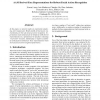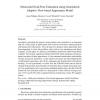417 search results - page 13 / 84 » Face Model Adaptation using Robust Matching and Active Appea... |
CVPR
2008
IEEE
16 years 1 months ago
2008
IEEE
Active Appearance Models (AAMs) typically only use 50-100 mesh vertices because they are usually constructed from a set of training images with the vertices hand-labeled on them. ...
FGR
2006
IEEE
15 years 5 months ago
2006
IEEE
In this paper, we present results on experiments employing Active Appearance Model (AAM) derived facial representations, for the task of facial action recognition. Experimental re...
CVPR
2007
IEEE
16 years 1 months ago
2007
IEEE
Appearance Models (AM) are commonly used to model appearance and shape variation of objects in images. In particular, they have proven useful to detection, tracking, and synthesis...
IVC
2010
14 years 10 months ago
2010
Accurately estimating the person’s head position and orientation is an important task for a wide range of applications such as driver awareness, meeting analysis and human-robot...
100
click to vote
ICCV
2009
IEEE
16 years 4 months ago
2009
IEEE
2D Active Appearance Models (AAM) and 3D Morphable
Models (3DMM) are widely used techniques. AAM
provide a fast fitting process, but may represent unwanted
3D transformations un...


